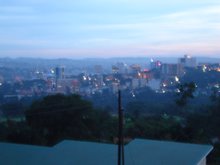
Our permits were for Habinyanja group, or H group, and our guide was named Kenneth. To find H group, we had to get back in our cars after a briefing at the park headquarters and drive about thirty minutes northeast. The only time we actually entered Bwindi Impenetrable Forest was for the briefing at headquarters.
The mountain gorilla is an endangered species. There are only 700 of them left in the world. They reside only in two areas. One is Bwindi Impenetrable Forest in southwest Uganda. The other is in the Virunga mountain range, which extends across three countries: Rwanda, the Democratic Republic of Congo, and a corner of Uganda. You can track the mountain gorilla in Rwanda and Uganda without a problem, as long as you can get your hands on a permit. (In 2007 the price of a permit was raised to $500 and the three countries agreed to keep it all at the same cost.) In Congo, as recently as July 2007, mountain gorillas were killed by the other kind of guerillas and the area remains unstable and dangerous. (The BBC has a nice feature online of a diary of the Congo mountain gorillas: here.) Bwindi has about half the population of the mountain gorillas within its forest, or about 340. Four groups of gorillas have been habituated for tracking and with eight permits available each day to tourists per group, that means there are 24 total permits available daily. (Two more groups in Bwindi are currently being habituated. One of these groups will replace M group, which has been tracked in Bwindi the longest, since 1993, and which now has an aging silverback at its helm. When a new silverback takes over the group, it will no longer be safe for tourists.)

We parked at the bottom of a steep hill with a wide dirt road running up it. With walking sticks in hand and porters as our caboose, we fanned out and began the steep climb. Later we dubbed it the pastoral route, as we passed through a local village’s farmland, plantations of tea and matooke and cassava. Small children followed us with their eyes, their elders mostly ignored us. It was steep, but otherwise not a difficult walk. There were always dirt paths to follow and Kenneth stopped often to let us rest.

After a little more than hour of walking Kenneth received a call on his radio: the gorillas were quite close. They were eating the bananas on someone’s farm and since the farmer preferred the gorillas off his land, it would be better if we hurried.
As we left the farms, the path grew narrower and the undergrowth thicker. Dark clouds gathered overhead. It was about 10:30 in the morning. We left our packs with the porters and took only our cameras with us the last few hundred yards to the gorillas. I followed closely behind Kenneth, leaving my family behind to take their time sorting out their belongings—considerate of me, I know—and as we turned a corner around a stand of trees, a crash of branches and a thick black shape took me by surprise. I had not realized they were so close.

It is a shock to finally see the mountain gorillas sitting before you on a hillside, calmly munching on a branch, fat as buddhas. They are lovely amongst the greenery, powerful, stately. They watch you with weary eyes, when they take any notice at all. The monstrous silverback sat under a low tree and never moved the entire hour we were allowed to visit with him. Nearby a three-month old gorilla swung from the branches of a taller tree, playful and energetic, while its mother sat in the seat of the trunk and sometimes watched, but mostly just ate. H group is 23 gorillas large and we had glimpses of eleven of them. The rest of the group’s presence was felt further up the hill, hidden in the bush, but evident in the sway of branches and the crash of broken tree limbs.

Our tracking group, in addition to the four members of our family, consisted of another American couple from Montana and two German women. Kenneth and two other assistant guides led us up and down the slippery hillside, cutting down low underbrush with a single swipe of a machete, and urging us closer and closer to the gorillas.

After thirty minutes it began to rain. Our porters appeared at the edge of the stand of trees with our packs so we could fish out our ponchos. The gorillas took cover in the bush. The silverback crossed his arms and edged closer to the tree for protection. The baby clung to its mother’s stomach, leaving only a tiny hand and a tiny foot visible from the side. The younger silverback in the group lay down on his side and rested his hand on his hands for a nap. We stayed for our entire hour, but there was little movement to be seen and mostly we just stood and watched the gorillas attempt to nap.
We were back at the Gorilla Resort by 1:00 PM. We spent the rest of the afternoon cleansing ourselves, eating, and napping – not unlike a bunch of gorillas.

No comments:
Post a Comment